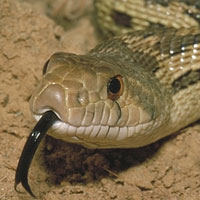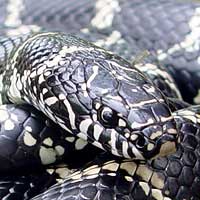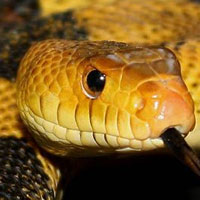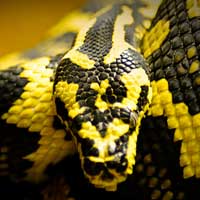Gray-Banded Kingsnake: Everything You Need to Know About This Stunning Reptile
The scientific name of the Gray-Banded Kingsnake is Lampropeltis alterna. It belongs to the Colubridae family, which is the largest family of snakes, including many non-venomous and mildly venomous species.
Scientific Name: Lampropeltis alterna
Snake Family: Colubridae
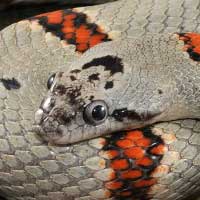
Introduction to the Gray-Banded Kingsnake
The Gray-Banded Kingsnake (Lampropeltis alterna) is a non-venomous and highly sought-after snake species known for its striking coloration. Native to the rocky desert regions of the southwestern United States, this species displays bands of gray interspersed with vivid orange or red, making it a favorite among snake enthusiasts. Its manageable size and calm temperament make it an ideal choice for both beginner and experienced reptile keepers.
Where Does the Gray-Banded Kingsnake Live?
The Gray-Banded Kingsnake is native to the arid and rocky landscapes of Texas and northern Mexico. Its ability to adapt to harsh desert conditions makes it a remarkable example of reptilian survival.
Preferred Habitat Features:
- Rocky outcrops and crevices
- Desert flats with sparse vegetation
- Arid grasslands
- Hillsides with loose rocks for hiding
| Region | Habitat Type | Key Features |
|---|---|---|
| Southwest Texas | Rocky desert | Loose rocks, minimal vegetation |
| Northern Mexico | Arid grasslands | Open areas, dry soil |
| Chihuahuan Desert | Hillsides | Crevices for shelter |
What Does the Gray-Banded Kingsnake Eat?
The Gray-Banded Kingsnake is a carnivorous predator with a diet that reflects its desert-dwelling lifestyle. It is an opportunistic feeder, consuming a variety of small prey.
Common Diet:
- Lizards
- Rodents such as mice
- Small snakes
- Insects (occasionally for juveniles)
In captivity, feeding frozen-thawed rodents is the most practical option. Juveniles should be fed every 5-7 days, while adults can be fed every 10-14 days. Always ensure that prey size is appropriate for the snake’s size to prevent choking or regurgitation.
Behavior and Temperament of the Gray-Banded Kingsnake
The Gray-Banded Kingsnake is known for its calm demeanor, making it a popular choice for those new to reptile keeping. However, it can be shy and prefers to remain hidden during the day.
Key Behavioral Traits:
- Nocturnal activity, most active during twilight
- Prefers to hide under rocks or in crevices
- Non-aggressive and easy to handle
- May become more active in captivity with consistent handling
With proper care and regular interaction, these snakes become accustomed to handling and can display curious behaviors.
Health and Lifespan of the Gray-Banded Kingsnake
The Gray-Banded Kingsnake is a hardy species with a lifespan of 15-20 years in captivity when properly cared for. Regular monitoring of its health and environment is essential to ensure its well-being.
Common Health Concerns:
- Respiratory infections caused by improper humidity
- Shedding problems due to low humidity
- Parasites, especially in wild-caught specimens
Maintain a temperature gradient of 75-85°F, provide a clean water source for hydration and soaking, and ensure a clean enclosure to minimize health risks. Regular check-ups with a reptile veterinarian are also recommended.
Reproductive Traits of the Gray-Banded Kingsnake
The Gray-Banded Kingsnake is oviparous, meaning it lays eggs after mating. Reproduction typically occurs in the spring, followed by egg-laying in early summer.
Reproductive Details:
- Mating season: Spring
- Clutch size: 4-10 eggs
- Incubation period: 50-70 days
- Hatchlings are independent at birth
In captivity, successful breeding requires simulating natural temperature cycles and providing a suitable nesting area. Incubate eggs at 82-85°F for optimal hatching.
How to Handle and Care for the Gray-Banded Kingsnake
Caring for a Gray-Banded Kingsnake involves creating a habitat that mimics its natural environment and providing consistent, gentle handling to build trust.
Handling and Care Tips:
- Handle gently and regularly to reduce stress
- Provide hiding spots such as caves or rock crevices
- Maintain proper humidity levels and temperature gradients
- Offer a varied diet of appropriately sized prey
With proper care, these snakes thrive in captivity, offering years of fascination and companionship to their keepers.
Other Snakes In This Species
 Albino California Kingsnake
Albino California Kingsnake Arizona Mountain Kingsnake
Arizona Mountain Kingsnake Black Kingsnake
Black Kingsnake Brooks Kingsnake
Brooks Kingsnake California Kingsnake
California Kingsnake Desert Kingsnake
Desert Kingsnake Dot-Dash California Kingsnake
Dot-Dash California Kingsnake Durango Mountain Kingsnake
Durango Mountain Kingsnake Eastern Kingsnake
Eastern Kingsnake Florida Kingsnake
Florida Kingsnake Florida Mole Kingsnake
Florida Mole Kingsnake Goins Kingsnake
Goins Kingsnake Gray Banded Kingsnake
Gray Banded Kingsnake Mexican Black Kingsnake
Mexican Black Kingsnake Mole Kingsnake
Mole Kingsnake Prairie Kingsnake
Prairie Kingsnake Ruthvens Kingsnake
Ruthvens Kingsnake Scarlet Kingsnake
Scarlet Kingsnake Speckled Kingsnake
Speckled Kingsnake Utah Mountain Kingsnake
Utah Mountain Kingsnake Variable Kingsnake
Variable Kingsnake



